
Alicante, a city rich in history and mystery, preserves a mystery that has persisted for over three centuries in its alleys and streets. At its center is the mysterious figure of Sister Úrsula Micaela Morata, a Capuchin nun whose body has remained incorrupt since her death in 1703. Although her story is widely known in Alicante, this Cartagena-born nun has been forgotten in other regions, despite the miracles and phenomena attributed to her.
The Secrets of Sister Úrsula, the Incorruptible Nun of Alicante
Sister Úrsula Micaela Morata could easily be the protagonist of a contemporary crime novel. Her gifts were not limited to religious devotion; she was attributed abilities that we now associate with superheroes or mystical figures from blockbuster films. According to chronicles of the time, the nun possessed the gift of bilocation, which allowed her to be in two places at once, and the ability to predict future events.
One of the most significant events was her famous prophecy about the overflowing of the Segura River, which transformed her into a kind of oracle. Her predictions were so famous that people, including such important figures as King Charles II and his half-brother Juan José de Austria, turned to her for advice. Sister Úrsula even exchanged letters with Juan José. But it was her death, or rather what happened afterward, that shaped the history of this nun in Alicante.
When she died on January 9, 1703, the Capuchin nuns guarding her body in a convent in Alicante discovered something surprising: After six days of vigil, her body was still warm and flexible, a phenomenon that defied any scientific explanation at the time. According to testimonies, a subtle, sweet scent of tuberose also filled the room, further strengthening beliefs in the nun’s holiness in Alicante.
A Life Marked by the Supernatural
Sister Úrsula’s path to holiness began in her childhood. Born into a wealthy family in Cartagena in 1628, she lost her parents early and experienced mystical episodes as a child. At the age of four, after surviving a bout of smallpox that nearly cost her her life, she claimed to have seen a “divine light” that made her believe she was already in glory. These mystical experiences only increased over the years.
As a young woman, she even prophesied the death of a priest close to her family. This prediction led her to abandon her former life and her boyfriend and enter the Capuchin monastery in Murcia. From that point on, miracles accompanied her: levitations, visions, and demonic attacks characterized her life until her death.
In 1672, Sister Úrsula came to Alicante to found a convent. She quickly earned the respect and veneration of the townspeople, and after her death, her body became the center of one of the strangest phenomena in history.
Alicante, Scene of the Mystery of the Mummified Nun
The decision not to bury her body due to the lack of signs of decomposition represented an unprecedented event. The people of Alicante witnessed a phenomenon that is still considered extraordinary today. The Bishop of Orihuela recognized the significance of this fact and in 1742 ordered that the nun’s body be kept in a special chest.
Despite repeated attempts to desecrate her remains, particularly during the War of Spanish Succession in 1706 and the 1931 Revolution, Sister Úrsula’s body remained in good condition, adding a new chapter to this historical mystery.
The Scientific Analysis That Confirms the Mystery
Throughout history, mummified or incorruptible bodies have been a source of wonder and controversy. Sister Úrsula’s case is no exception. In 2009, a forensic analysis of her remains was conducted in Alicante, which could easily have been part of a CSI episode. The Alicante Institute of Legal Medicine confirmed that the natural mummification process is real. What most astonished the experts was the absence of microbial life in her remains, a fact that continues to baffle scientists.
The mystery surrounding Sister Úrsula Micaela Morata remains a case that defies both science and faith. Her story, which has stood the test of time, continues to fascinate both Alicante and the world. For those who wish to delve deeper into her legacy, there is the opportunity to view her immortal body at the Capuchina Convent in Alicante.
This monastery, custodian of their memory, offers a unique opportunity to learn more about one of the most impressive mysteries in Spanish religious history. It reminds us that it is often the inexplicable that captivates us most.



